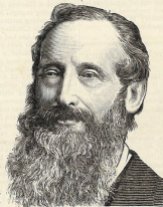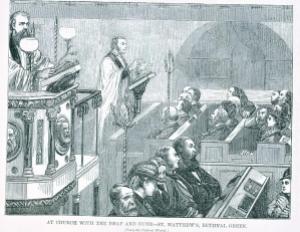
This post has been shared with the kind permission of St Chrysostom’s Church.
Back in the early nineteenth century society tended to write off deaf people as deaf and dumb, deaf mute, incapable of learning or achieving anything, fit only for menial, manual labour.
Spiritually they were often seen as not much better than animals (being without speech and therefore lacking something that was seen as essentially human) – and certainly not seen as able to engage in theological discourse and debate, or to preach, or lead a church.
The early deaf schools in the late 18th century/ early 19th taught pupils to read and write using what was called the manual method or method of signs. Sign language was not seen as a language in its own right, but a series of gestures that deaf mutes could make to communicate bodily needs but not a fit way to communicate about or to God.
In the midst of all this, four educated deaf men (possibly privately educated from wealthier families) got together in Edinburgh on 30th June, 1830 and began a church where the gospel could be preached, prayers could be said, psalms could be shared all by means of the despised language of signs.
These four men – Matthew Robert Burns, Alexander Blackwood, Walter Geikie and Joseph Turner – challenged the accepted perception of deaf people and founded a movement that still exists today.
From that beginning in Edinburgh, the news spread of this new idea that deaf people didn’t have to wait for hearing people to take pity on them, they could preach and teach themselves. Deaf churches were founded in London, South Wales, Manchester and Liverpool by people who had direct contact with members of the Edinburgh group, especially Matthew Robert Burns.
Matthew Burns, 1798 – 1880
But they weren’t the only deaf people challenging convention. William Griffiths, a brass chaser in Birmingham, studied late into the night to improve his English so he could write letters campaigning for funds and a room so he could preach to his deaf brothers and sisters. Eventually, after 7 years, his persistence paid off.
Or Charles Davis, a cobbler in Stoke-on-Trent who used his shop as a base to get deaf people together and teach them the Gospel.
A service being signed at St Matthews, Bethnal Green, 1875 while hearing people listen to the preacher
In those early days, it wasn’t just spiritual salvation they were teaching. A mutual benevolence was also encouraged following the example of Acts 2. People were encouraged to pay into the society what they could afford so as to develop a ‘pot’ which could be drawn on by members in time of need.
Unfortunately this radical, deaf led, mutually benevolent society of the gospel didn’t last. Active suppression of sign language in schools beginning in 1880 and lasting over a century damaged the education of deaf people so much that as the old deaf missioners died out, they were replaced by hearing men because there were no longer deaf people with the ability to read and write sufficiently well for the increasingly ‘professionalised’ role.
The church took pity on these poor ‘deficient’ people and started providing welfare and spiritual services to the deaf community, founding more churches and spreading the story that we deaf people owe hearing people our church and our opportunities today.
But the memory and the story of those early deaf men survives – we who are deaf leaders in the deaf church today know we aren’t the first, that it has been done and can be done and are encouraged to follow in their footsteps.
Hannah Lewis was born deaf on one side, this was not detected (Hannah thinking it perfectly normal to only hear in one ear) until her other ear also became deaf age 8 after scary bouts of tinnitus. She discovered BSL and the Deaf community and her Deaf identity in her late teens and is now bilingual in English and BSL. She was the first deaf person to obtain a PhD in Deaf Theology and her thesis was published as Deaf Liberation Theology in 2007. She has been a Church of England priest for 20 years, currently working as minister with the Deaf community for Liverpool Diocese.























Hartmut
February 23, 2017
Interesting etching showing the use of signing hands. The lay reader looks a lot like Matthew Burns.
More interesting are the five hearing persons facing away from the altar.